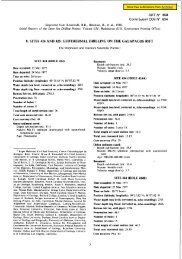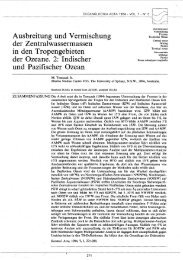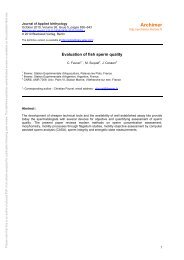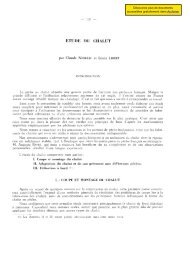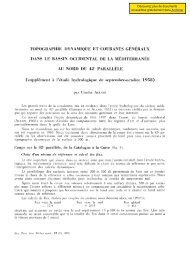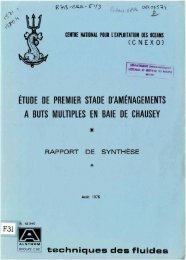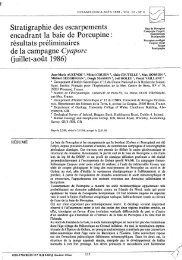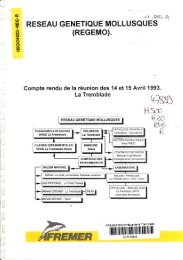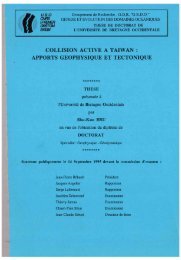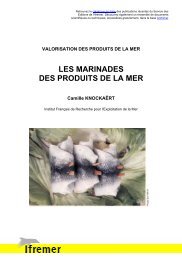Contribution à l'étude de virus de mollusques marins apparentés ...
Contribution à l'étude de virus de mollusques marins apparentés ...
Contribution à l'étude de virus de mollusques marins apparentés ...
Create successful ePaper yourself
Turn your PDF publications into a flip-book with our unique Google optimized e-Paper software.
70<br />
ln th e rirsl ex perimcIlls, wc have in oc ulalCd cc lls<br />
obtain cd fro m 1.7 dissociated venll'icles l'cr f1a sk.<br />
But best growth results were further obtaincd when<br />
cell s from 3.5 venll'icles were inocll'ated per f1 ask.<br />
In<strong>de</strong>ed. as much cell s died quickly, on the first two<br />
days, il \Vas necessary to inoculated a grc3t numbcr<br />
of eells 10 rccover enough anchored cells. Moreover.<br />
a grea ter number o f ancho red ec ll s provi<strong>de</strong>s an exlrace<br />
llular microenvironment w llich could enhance Ihe<br />
cc II growth and me ta boli sm 17, 13J. T hese resu lts<br />
also suggest Ihat sOllle celllypes may relcase fa ctors<br />
necessary for the <strong>de</strong>velopment o f other cell types.<br />
Such a coopera tive growth may need a greatcr<br />
nllmbc r o f ccll s per f1ask .<br />
Moreover, previous poly-D-Iysin coating of f1 asks<br />
facilitated the ccii at tac hment. The examination of<br />
cultures un<strong>de</strong>r light inverled micro scope did not<br />
reveal noticeable differences between poly-D-Iys in<br />
coated and control f1 asks on the first days. But 6 ta<br />
7 days later in control f1a sks, cel ls started to <strong>de</strong>tach<br />
while cell s still anchored exhibited poor preserved<br />
aspect. In pol y- D-Iysin coated f1asks, cells remained<br />
healthy, adhesivc and growing for at least 15 days<br />
(Figure 2). It is weil known that the extracellular<br />
cnvironment is of great importance si nce il influences<br />
the metaboli sm or cells, but also the cytosqueletton<br />
structure and thus, the morphology of cells in vivo<br />
and in vitro [1 J. Moreover, the previous coating of<br />
f1a sks with poly-D-Iysin by enhancing the anchorage<br />
of cell membrane to the plastic f1a sk bottom, also<br />
promotes the ccii division [13J.<br />
Last of ail, we supposed the presence of growth<br />
factors or nutriti ve eleme nts in the hemolymph of<br />
oyster [1 2] and we have modified this procedure for<br />
primary culture of oyster heart cells by adding oyster<br />
hemolymph to the c ulture medium. We compared<br />
medium L- 15: sea water ( 1: 1) supplemented wi th differen<br />
t combinations of 0, 1,5 or 10% COH and 0, 5<br />
or 10% FCS. We found that the presence of 5 ta 10%<br />
FCS was necessary. 1 % COH was not different From<br />
control 0% COH. While, in 5% COH supplemented<br />
medium. cc II growth scc mcd ta be better becausc cell<br />
layers looked more <strong>de</strong>nse, however, ce ll preserv ation<br />
did not extend in time. Whereas. the presence of 10%<br />
COH seemed to be taxie ror cell s, as they were more<br />
damaged than in co mml without CGH.<br />
lt is important to mention that propenies or CGH<br />
are greatly affected by freezing to - 20 oc. In<strong>de</strong>ed,<br />
improveme nt of cc II growth wit h COH di sappeared<br />
artel' thawing but more , il became a Few damag ing<br />
to cells. Lyophylisation and storage at 4 oC seemed<br />
beller si nce no difference was ûbserved between<br />
Iyophylised and fresh COH. However, the preservati<br />
on o f suc h Iyophilised COH is unknown for very<br />
long periods.<br />
By transmi ss ion eleclron mi croscopy examinatioll,<br />
different cell types could be i<strong>de</strong>ntified in the cultures.<br />
They werc mostly card iomyocytes (Figure 3), fibreblast-like<br />
cell s (Figure 4) and pigmented ce ll s (Figure<br />
5). Other cell types we re supposed to be haemocytes,<br />
particularly granulaI' type hae mocytes were fre <br />
quently observed (Figure 6).<br />
These observ at ions revcalecl th e weil prese rved<br />
ultrastructurc of mûst of the cullured cells. This seem<br />
to indicate that they kcep a correct bi ological activity<br />
since thei!" aspect \Vas similar la th ose of the cells<br />
observed in Silu , in non di ssoc iated ventricles fixed<br />
with g lutaral<strong>de</strong>hy<strong>de</strong> just after dissection . However,<br />
pigmented ce Ils present in cultures were less pigmented<br />
th an the same type of cell s observed in situ ,<br />
indicati ng that they may have released a part of their<br />
pigments (Figure 5). Transmi ss ion electron mi cro <br />
graphs also indicate tha t some cell s <strong>de</strong>generate with<br />
time in cu lture . In<strong>de</strong>cd. il \Vas observed myelin<br />
figures corresponding to the accumulation of <strong>de</strong>gra <br />
dation products.<br />
The different cc ii types present in the cultures<br />
offer many possibilities of applications of thi s<br />
method. Particularl y, the presence of fibroblast-like<br />
cells in these primary cell cultures allows us to plan<br />
10 inocu late herpes- like viru s of C. gigas larvae in<br />
these cultures. In<strong>de</strong>ed, thi s viru s hold s a major<br />
Figure 1. Focus of growi ng fibroblasti e type ee ll s appea r on the thinl day of cu lture in 10% FCS supple mented<br />
L·15:sea \Vater (3:2 and 2:3) medium.<br />
Figure 2. Monolaycr of ten da ys cultured cell s in poly-D-Iysin coated Oasks and in the presence of the optim ized<br />
med ium.<br />
128



